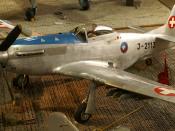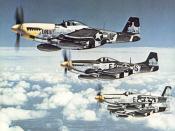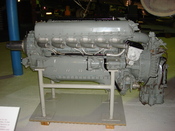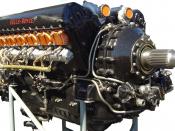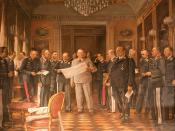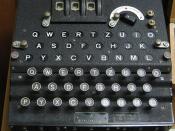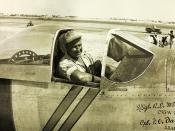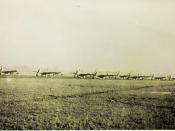P51 D Mustangs The P51 D Mustang is one of several in the line of mustangs though it was the peak of the plane's line. The plane could do almost anything and go anywhere toward the end of the war. The P51 D Mustang was one of the most revolutionary planes introduced in the 1940's.
The P51 D Mustang took flight for the Royal Air Force in the 1940's as mainly a gap fighter. Although when they combined the Rolls Royce Merlin V12 engines, it quickly turned into one of the best fighters during World War II. The D model was special due to how it was designed. The D model's normal take off weight was 10100lbs where as the A model was 8600lbs the max weight for these were both 2000 pounds more. The beauty lied in the power-plant the D model had the Rolls-Royce Merlin 68 v-1650-7, and the A model had an Allison v-1710-81 the normal take off horse power of the Allison was 1200 where as the D model had 1490 hp of take off power with a max of 1720 for war emergency.
The D had it beat in hp, range, altitude, weapons, and others. The D had a service ceiling of 41900 opposed to 31350 on the A model. D model could travel in combat 950 miles with a fuel capacity of 269 gallons, and a range with drop tanks of 1855 miles allowing it to go virtually anywhere. There were other models in the series though none could compete with the D. The P51 D had 6 .50 caliber machine guns and could hold 1880 rounds, 2 1000lb bombs, and 10 five inch rockets. Making it a heavy gun-ship, many would think of this plan as being slow and unmaneuverable, quite the contrary. The D could cruse at 377mph at 25 thousand feet, and could turn on a dime. The D had one of the fastest turn ratios of all planes in that time period. The plane was one bad thing to come across if you were not on its side (Web, 1).
The P51 contributes much to the victory of the Allies in the Europe during World War II. On September 1, 1939, the German military forces invaded Poland leading to World War II. With it the strategic theory termed "Blitzkrieg", literally meaning Lightning war, which was very affective, the speed and coordination of the distinct forces of the Germans, the Wermachts', and the Luftwaffes', dominated the opposing forces of the Allies in the beginning of the war. The Luftwaffe being the advanced air force dominating the air, disrupting communication and transportation. Grouped with the Wermacht the advanced ground forces, attacking enemy ground forces. These combined made the invasion of Poland, Norway, Western Europe and the Balkans successful. The Luftwaffe dominated the air after the first of September, because no other nation could match the planes technology, or numbers. That was of course until the United States joined the war effort that great damage was done to Germany, even then the German air superiority remained unscathed. The Allies were able to succeed with the domination over the German's Luftwaffe with the introduction of the P-51 Mustang and all the improvements, benefits, and side effects that came with it. This quote shows the effectiveness of the p-51's "The first effect that the Mustangs had was in the running air battles over Europe. Before the beginning of 1944, the bombers had been alone as they approached their faraway targets. The P-51 changed this, and quickly made and impression on all concerned, enemy and ally alike. For example, on January 11, 1944, the Eighth Air Force launched its first deep penetration of Germany with P-51 coverage. The bombers' targets were the cities of Oschersleben and Halberstadt, where many German planes were being constructed. When they arrived, there were 49 Mustangs covering a force of around 220 bombers. Even though the bombers suffered heavy casualties, they were able to inflict substantial damage on their target factories. But the most significant thing about the battle was the shining performance of the P-51's. Since the bombers were attacking two different cities, the Mustang force had been divided into two groups, to support the different attacks. Because of the sensitive ensuing melee, the 49 P-51's shot down 15 enemy planes without suffering a single loss. Major Howard, the group's leader, was credited with four kills within minutes." this shows the advantage the P-51's had over the Germans, keep in mind that these were first-time pilots in the Mustangs' first big battle (Buckingham, 2). The planes caused Germany's Luftwaffe tactics to be changed. The Germans usually rushed in shooting everything in sight, until the P-51 was introduced they had to change their tactics to fly a distance away until their was an opening when the P-51s were not in sight. Then they would turn and try to do as much damage as they could in one pass before the P-51's got there. At one point in the war the German commander of the Luftwaffe, recommended that the German defensive fighters avoid combat with the P-51, and only attack bomber formations when there were no fighters around. As a result there were not many bombers shot down. One stated that the safest place to be was in the cockpit of a P51. It was used in roles ranging from close air support and ground attack to long range bomber escort. It was also the first fighter with enough range to reach Berlin from England and return. It was stated that when Hermann Goering, the leader of the Luftwaffe, saw the Mustangs over Berlin for the first time he declared that "Germany has lost the war" (Web, 4).
The P51's had its problems like any other plane shown in the following list of accidents (Web, 1).
These clearly show some of the problems that the P 51's had, some pilot error, but many problems from the plane its self. This list was submitted to help educate the pilots and crew, so these mistakes aren't made again. Most causes of P 51 accidents wouldn't be a big issue in other aircraft, but fuel management, airspeed control, and taxiing visibility come to mind. The visibility on the P 51 while taxing is somewhat limited due to the plane being pointed up in a resting or taxiing position. The small bubble canopy of the P 51 doesn't give much in the way of visibility while taxiing. Factors such as weather, fuel exhaustion and mechanical problems wasn't much of an issue for the P 51, as they are in most planes. Mechanical problems happen to all airplanes, especially the older ones. The old engines of the 1940's were not built for use over many years. They were built for the highest performance, and require maintenance frequently. When maintained though they are very dependable. Most accidents occurred when landing on an airfield other then the one they were normally stationed at, to get reloaded. These accidents usually consisted of loosing power when landing. Most of these incidents left the pilot with minor bumps and bruises (Web, 1).
The P 51 Mustang symbolized American Airpower in World War II to many Americans. Its pro high altitude escort fighter forged its reputation as the possibly the greatest piston fighter of them all. While some might argue the fine points, there is no denying that the Mustang was a superb aircraft by any measurement. In an era where speed rather then maneuverability was beginning to play a bigger role in air combat, the Mustang was the ultimate high-speed machine. Except for a very few late war Axis and Allied designs the Mustang was the fastest mass production plane to see widespread service. Its astonishing endurance (over 2000 miles with drop-tanks), decent ammo, and ordnance load made this a very effective fighter.
Strengths: Speed and Energy retention. Use them wisely. Good Mustang drivers use these as their "Ace in the Hole" rather than a crutch. Poor Mustang drivers (the infamous "Runstang" types who have to extend 10,000 yards before attempting another pass aren't using the plane to its best potential. All those types do is to frustrate their opposition, plus doing their best to give Energy Fighting a bad name. The better pilots use that burst of speed only needed. The P 51 handles very well at intermediate speeds and superbly at high speeds. The P 51 is a good ground attack plane, although it doesn't quite carry the same ordnance levels as some of the other pieces of Heavy Iron in the American inventory. The P51D's boubble canopy gives the plane among the best visibility levels around. The p 51 has a very fast-sustained drive, but some planes actually have a faster initial dive acceleration. This is of course critical in those first few moments when you are trying to break away. The P 51's big gastank allows it to cruse seemingly forever even on a partial gas load. With 35-40% gas in the area, the p 51 can range far and wide and this allows the pilot the time to be patient. In Scenario's the 51's range is even more important.
Weaknesses: Don't dogfight with this plane. Many people familiar with its sterling historical reputation are surprised at the Mustangs poor sustained turn. While the Mustang is a great plane it can't do everything. As a "Boom and Zoom" Energy Fighter it has few peers, but as a "Turn and Burn" dogfighter it is rather weak. Keep to the planes true strengths and you might live to land that sortie.
The P 51 suffers from lack of really lethal gun punch. The much maligned .50 caliber machine guns seems a bit more effective now then they were during the days of beta, but a robust burst is still needed to shoot down the target. While an incidental hit from 20mm canon can often cause a critical hit, this is hardly ever the case with the 50's. Also with its wing mounted guns, the Stang driver not only has to be a good shot, but he has to make sure he lets off his killing bursts very close to his set convergence. Otherwise he might see bursts of fire virtually "bounce off" the target with no noticeable effect.
The Pony is a good ride and one of the most survivable planes if flown well. People who think that they can use speed to make up for poor flying will probably be saddened to hear that the Mustang is not a super-plane that will save them from their own ACM blunders. The Mustang is one of the best Energy Fighters, and it handles like a dream and its sheer speed makes it a very hard plane to pin down. The plane also allows the pilot superb visibility from within its generous bubble canopy. This really helps, and can easily be overlooked, but is quite vital.
In the hands of a master who maintains excellent situational awareness, this plane can be almost invincible. The smart Mustang driver uses excellent Situational Awareness and engagement savvy. He uses "pick out a target" opportunism to score kills. Flying this plane well requires minimal stick input! Remember that while the Mustang is fast - it is not outrageously faster than some other planes which are pretty fast movers themselves. At low altitude a couple of planes are in fact a tad faster than the Mustang. For this reason the Mustang driver should always keep the comparative Energy State of enemy planes in relation to his plane at the very top of his list of things to consider.
The Mustang is not a good Turn and Burn plane. It does not shine at all in a furball. However the Mustangs high speed means that if the mustang driver really knows his business he can attack with virtual impunity when he does attack. Even though some folk malign its performance, the Mustang is still one of the best Energy Fighters around. The Mustang handles well at high speed and has a good instantaneous turn. The Mustang is a pretty hard target to hit because of its color scheme and compact shape.
The Mustang has a couple of other tricks. If its starts fast with a bogy close in its six, sometimes it can get away with one G-load turn. Because it holds Energy so well, it will come out of the turn faster than its pursuer and will be able to escape. Also the Mustang is a King of the High-Speed turn. Since it can pop on notch of flaps at very high speed, the Mustang can do often out turn planes at those speeds.
The P 51 is generally accepted to have been the best fighter of the Second World War. Moreover, there are many aviation historians who consider the P 51 the greatest overall fighter OF ANY PERIOD. The Mustang was one of the most pilot friendly aircraft.
Bibliographies "Http://www.p51.mustangsmustangs.com/p51specs.shtml", 1/23/01 2.) Buckingham, David. "http://cpcug.org/user/billb/mustang.html", 1/23/01 3.) http://www.p-51mustangs-aliveandwell.com/aircraft/thep51listHOME.shtml, 1/23/01
